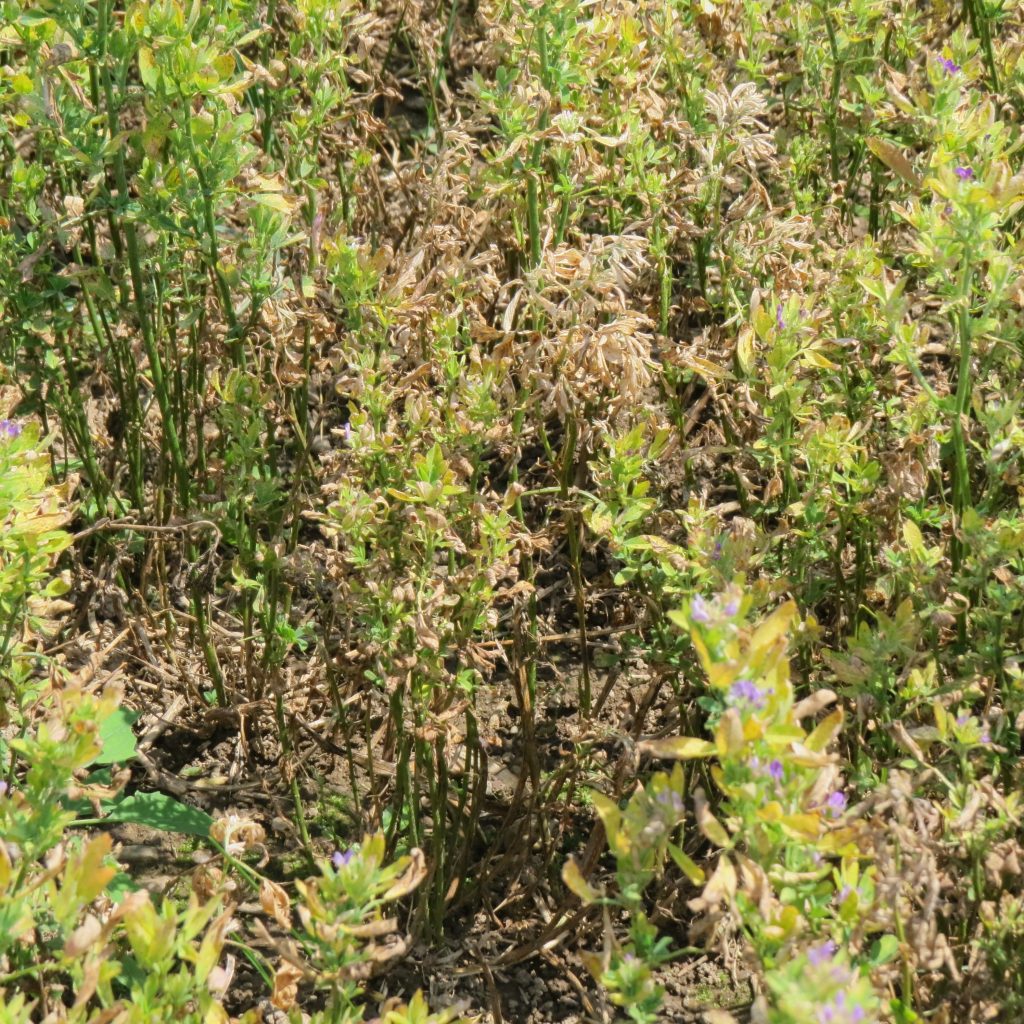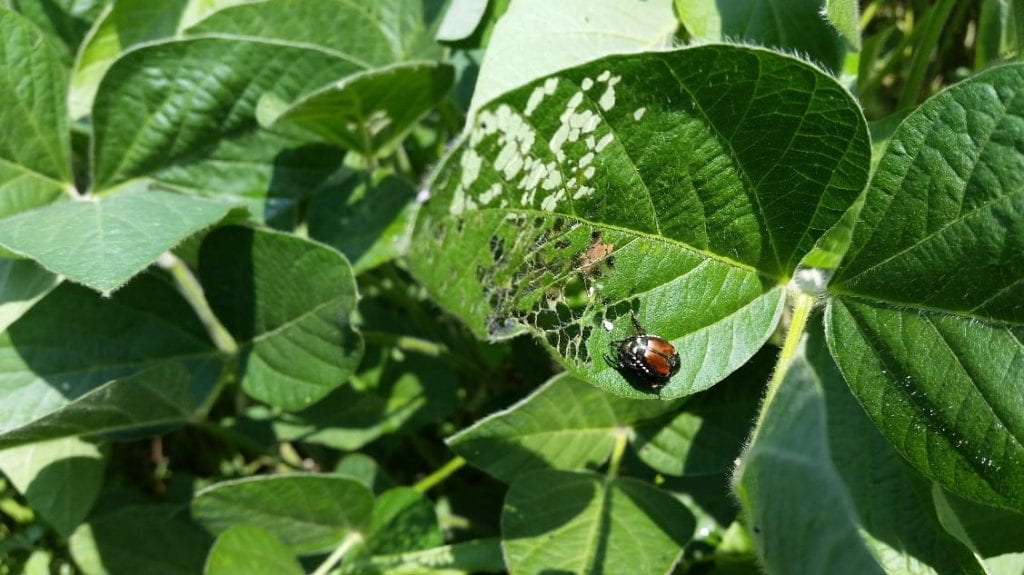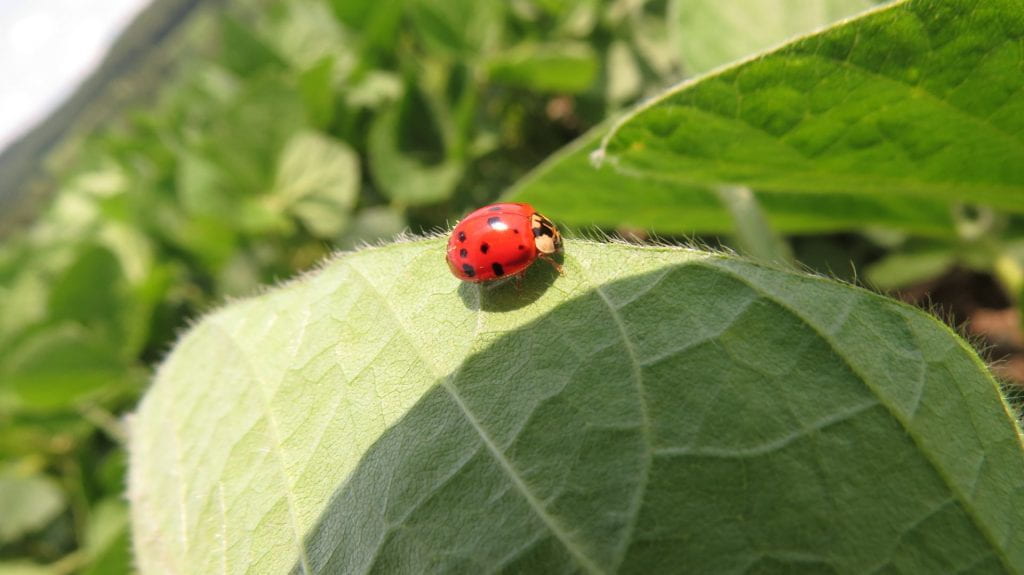Volume 19, Number 11
Contents
View From The Field
Potato leafhopper
Potato leafhopper populations are still very high in alfalfa. Many fields are over threshold statewide. The hot, dry weather is adding to the problem because potato leafhopper thrives in these conditions. In addition, the lack of moisture in the soil adds a second stress on the plant. These two stresses can cause significant quality and yield losses in the alfalfa.
Western Bean Cutworm
Western Bean Cutworm pheromone trapping has started statewide! We are starting to catch low numbers of moths. There have been a few hot spots with one trap breaking a hundred moths. Many of the traps will be reporting next week and will have a better idea of the flight of the moths. Peak flight normally occurs the last week in July or the first week in August.
Japanese beetle
Japanese beetle is showing up in soybean fields. They are still at low to moderate levels. For more information on Japanese beetle, view the following issue: 7-6-2020 NYS IPM Weekly Field Crops Pest Report
Spider mites
Spider mites are starting to show up on soybeans. Spider mites really proliferate under hot-dry weather conditions. For more information please view the new article Jaime Cummings has prepared on spider mites.
Spider mite damage on soybean (photo by M. Stanyard, CCE)
Soybean Diseases
Several low to moderate levels of foliar diseases are starting to show up in soybeans. Generally, they do not cause much yield losses in most years. For information on soybean diseases and management recommendations for NY, please see the soybean disease website. The following diseases are currently being reported:
Septoria brown spot on soybean (photo by J. Cummings, NYS IPM)
Soybean aphids
Soybean aphids were found at very low levels this week in soybeans. Many times this insect pest is control by natural enemies like lady beetles. I saw a few species of lady beetles in soybeans this week.
Stored Grain Pests
Small grains harvest is underway. These grains will be stored in on-farm bins. There are some important factors to consider. Many insect pests like rice weevil, maize weevil, granary weevil, lesser grain borer and Indian meal moth can still be in the bins even when you think it might be empty. The majority of the insect pests I have seen while monitoring stored grain bins have been weevils. Here are a few steps to help limit these pests from infesting your new grain:
- Cleaning, cleaning and more cleaning. Make sure to get all the old grain out of the bin. Remove the grain from under the floorboards. I know it is a pain but this can be a reservoir for these insect pests. It does not take many of these insects to re-infest and proliferate. This is by far the most important step in the process.
- Make sure to seal up holes, cracks and openings in the bin. Openings in the bin is a good way for some of these insect pests to enter.
- You can treat the inside of the bin with an insecticide to kill the remaining insect pests. If you were unable to clean under the floorboards, it might be a good idea to treat this area.
- Clean the grain before placing it into the bin.
- Make sure not to store new grain on top of the previous year’s grain. This is a very easy way to have the insect pest infest the new grain.
- If possible, cool grain down below 50 degrees. This limits insect development.
- Make sure to dry the grain down to limit available moisture.
- Make sure the grain is distributed uniformly within the bin.
Growing Degree Days at Base 50 Degrees
Starting March 1 to Present
| Station Location |
(Base 50) March 1 |
| Canton | 1237 |
| Ceres | 1123 |
| Chazy | 1175 |
| Geneva | 1358 |
| Highland | 1467 |
| Ithaca | 1271 |
| Kinderhook | 1442 |
| Malone | 1138 |
| Massena | 1204 |
| Oriskany Falls | 1267 |
| Red Hook | 1453 |
| Versailles | 1282 |
| Watertown | 1225 |
Clipboard Checklist
Keith Waldron, NYS IPM
General
*Walk fields to check general field condition, weed issues
*Watch for crop maturity, stand assessments, weed escapes, nutrient deficiencies, lodging issues
Alfalfa:
*Evaluate established legume stands for approximate days until harvest
*Monitor potato leafhopper, foliar, systemic and crown rot diseases.
*Monitor new seedings for potato leafhopper, pythium blight, phytopthora root rot.
Small Grains:
*Monitor spring small grains for signs of Fusarium Head Blight, foliar diseases
*Monitor grain fields for growth stage, disease and lodging issues, grain maturity, harvest timing
*Record diseases present, location and types of weed escapes
Corn:
*Monitor for mid-season corn pests including European corn borer, corn rootworm, western bean cutworm, slugs, foliar diseases such as northern corn leaf blight and gray leaf spot, weed issues, nutrient deficiencies, vertebrate damage.
Soybeans:
*Monitor for crop growth stage, soybean aphid, defoliators, foliar diseases, white mold, weed issues, vertebrate damage
Pastures:
*Check water sources, mend fences as needed.
*Check crop growth, clip pastures between grazing as needed
*Monitor for invasive species, plants harmful to livestock
*Review/Plan rotations
Storage:
* Check stored grain bins for temperature, moisture and signs of mold and insects. Aerate, core, transfer grain or treat as necessary
* Clean and disinfect empty storage bins in preparation for grain harvest
*Check forage allocation and anticipate feed program adjustments as forages from previous year are used up
*Mow around storage bins and facility to minimize pest hiding places
Dairy Cattle Barn Fly Management:
*Monitor animals and barn area for house fly, stable fly and other pest management needs including presence of rodents and birds.
*Check facilities for favorable fly breeding conditions: (organic matter + moisture): leaks in watering systems, roof gutters for leaks and potential overspill, drainage,
*Sanitation, sanitation, sanitation – clean animal resting areas, feed troughs, minimize source of moist organic matter i.e. fly breeding areas in barn and in adjacent animal loafing yard
* Continue fly monitoring: install “3X5″ index card fly speck monitoring cards throughout barn
*Use, replenish, replace fly management materials: sticky fly tapes/ribbons, insecticide baits, natural enemies (parasitoids), fly population monitoring (3 x 5) spot cards
*Consider purchase and release of Muscidifurax raptor and/or M. raptorellus natural enemies of house and stable fly pupae.
Dairy Cattle on Pasture:
*Monitor animals for presence of face flies, horn flies and stable flies. Action guidelines: face flies (average 10 per animal face), horn flies (average 50 / dairy per animal side, 200 / beef cattle per animal side), stable flies average 10 per animal (all four legs)
*Check feed bunk / water source locations for signs of stable fly breeding (moist undisturbed organic matter – spilled feed, round bales, etc.), minimize source of moist organic matter i.e. fly breeding areas in barn and in adjacent animal exercise yard.
*Check pasture for forage quality / quantity, rotate as appropriate
*Check pasture for vegetation poisonous to livestock
*Consider use of pasture fly traps to help reduce deer, horse and stable fly populations







